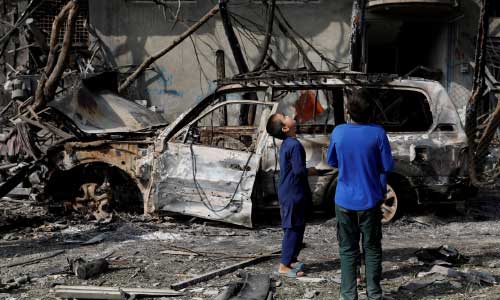KABUL - The number of Afghan civilians killed and injured in the conflict has failed to slow since the start of intra-Afghan peace talks, the United Nations said on Tuesday.
The overall civilian casualty figures for the first nine months of the current year fell by around 30 per cent, compared to the same period in 2019, the UN Assistance Mission in Afghanistan (UNAMA) said.
In its quarterly report, the UN mission documented 5,939 civilian casualties --2,117 killed and 3,822 injured from 1 January to 30 September 2020.
High levels of violence continued with a devastating impact on civilians, as Afghanistan remained among the deadliest places in the world for civilians, the report added.
Although the civilian casualties registered are the lowest in the first nine months of any year since 2012, the harm done to civilians remained inordinate and shocking, the mission noted.
UNAMA reminded all parties to the conflict that they could and must do more to protect civilians by urgently reviewing practices and strengthening mitigation measures, as well as working towards an end to the fighting.
UNAMA stands ready to further assist all parties in taking the urgent steps needed.
From September 12, when peace negotiations between the government and the Taliban began in Doha -- to September 30, there was no reduction in the documented number of civilian casualties in comparison to previous weeks.
The mission voiced concern at intensification of the fighting in Helmand, indiscriminate attacks in Nangarhar, Laghman, Ghor, Takhar and Kabul. More than 400 civilians were killed and injured in these attacks.
The secretary-general’s special representative for Afghanistan said: “The (Doha) talks will need some time to help deliver peace. But all parties can immediately prioritise discussions and take urgent, and frankly overdue, additional steps to stem the terrible harm to civilians.”
Deborah Lyons believed new thinking and concrete action would not only save thousands of families from suffering, but would also bolster confidence and trust among negotiators.
The mission supported the renewed call by UN Secretary-General Antonio Guterres for a global humanitarian ceasefire to be in place before the end of the year.
Such a pause to the conflict in Afghanistan would help the fight against COVID-19, as well as reinforce critical efforts to prepare humanitarian assistance for millions of the most vulnerable Afghans.
More than four of every 10 civilian casualties are children or women. Child casualties during the period were recorded at 31 percent of all civilian casualties. Women casualties were put at 13 percent.
Anti-government elements (AGEs) were blamed for 58 percent of civilian casualties.
The number of civilian killings attributed to the Taliban increased by six percent. In contrast, the overall number of civilian casualties attributed to the rebels dropped by 32 per cent.
The drop was linked to a reduction in the number of civilians injured by suicide attacks and ground engagements, though it was partially offset by an increased number of civilian casualties from targeted killings and indiscriminate pressure-plate improvised explosives devices.
Children made up 31 percent and women 12 percent of civilians killed and injured by pressure-plate IEDs. UNAMA asked the Taliban to meet its commitments and cease using these illegal weapons.
The report said in the period under review, there were fewer civilian casualties attributed to the ISIL-KP due to a decrease in the number of attacks.
Ground engagements, mainly between the Taliban and the Afghan forces, accounted for a third of all civilian casualties. This was followed by suicide and non-suicide IEDs (29 percent), targeted killings (16 percent) and airstrikes (eight percent).
Pro-government forces (PGFs) were responsible for more than a quarter of all civilian casualties – 28 percent. Civilian casualties attributed to them declined by 34 percent in comparison to the same period in 2019.
The fall was largely due to the steep drop in international military forces (IMF) airstrikes since March 2020.
Afghan forces were responsible for 23 percent of all civilian casualties; a similar number gad been recorded in the first nine months of 2019.
Civilian casualties attributed to the Afghan National Army increased by 25 percent due to a hike in civilians killed and injured from airstrikes and ground engagements.
UNAMA expressed its concern over the 70 percent increase in civilian casualties caused by Afghan Air Force airstrikes that accounted for most of the airstrike civilian casualties, which amounted to eight percent of civilian casualties.
In contrast, the report said, since the United States-Taliban Agreement of 29 February, civilian casualties caused by international forces, which had been mainly from airstrikes, all but ceased in the reporting period. (Pajhwok)
Home » Afghanistan » Despite Peace Talks, Civilian Casualties Stay High
Despite Peace Talks, Civilian Casualties Stay High

